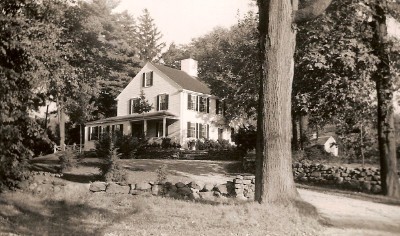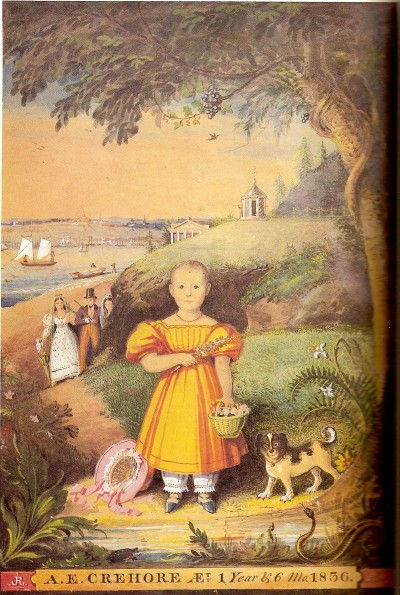
|
|
The History of the Diana Grape Has Roots in Milton by Anthony M. Sammarco (from our Fall 2008 Newsletter) In the early 19th century, many people throughout the Boston area became ardent members of the Massachusetts Horticultural Society, a newly founded organization that was established on June 12, 1829 for "the purpose of encouraging and improving the science and practice of Horticulture, and promoting the amelioration of the various species of trees, fruits, plants and vegetables, and the introduction of new species and varieties." Horticulture, which has been described as "the art or science of growing fruits, flowers and vegetables" was the direct result of a diminishing agrarian culture in New England in the 19th century and the rise of the affluent gentleman farmer. The first president of the new horticultural society was Henry A. S. Dearborn, whose Roxbury estate, known as Datchett House, was located on the western slope of Parker Hill. The grounds of his estate were a lavish display of horticultural pursuits from the impressive hybrid flower beds, extensive fruit orchards and terraced lawns that extended towards the present Museum of Fine Arts. His term as president, 1829-1834, served to form the goals and aspirations of the society, and he was instrumental in the laying out of Mount Auburn Cemetery in Cambridge and Forest Hills Cemetery in Jamaica Plain as "arboretum cemeteries." Among these new horticulturists was Diana Ames Crehore, wife of John Shepard Crehore of Brush Hill. The Crehores were descended from Teague Crehore who had settled in town in the mid-17th century after having emigrated from Ireland. Diana and John Crehore, who were married at the Milton Meetinghouse (now First Parish, Unitarian) on March 9, 1817, kept an extensive dairy farm in the western section of town near Paul's Bridge, originally known as Hubbard's Bridge, which had been in the family since the late 17th century.
It was here that they commercially raised the first strawberries to be sold at market, and where Mrs. Crehore began to experiment with the hybridization of a seed of the Catawba grape. During this period, European seedling grapes had been almost wholly abandoned, and the new hybrid, justifiably called the "Diana" grape in honor of its cross breeder, was "thus an important addition" to the indigenous species. The Diana grape was an early hybrid of native grapes that had grown in New England, of which there were over 20 wild varieties by 1835. So important was this new hybrid grape that it was exhibited at the weekly displays at the Massachusetts Horticultural Society's rooms on School Street in Boston. The grape hybridizer's husband, Mr. Crehore, was not only a farmer but a noted chair maker who was in partnership with Lyman Davenport; their chair factory was located on Mr. Davenport's property at 1631 Canton Ave. and the chairs were said to be "prized for their comfort and durability." Obviously, his factory was quite successful and he was in a comfortable position, for he commissioned his daughter's portrait to be painted in1836 by the noted Roxbury artist John Ritto Penniman.
Seen in the accompanying photograph, Ann Elizabeth Crehore, age "1 Year & 6 Mo[nths]," stands on Milton Hill in 1836 attired in a fashionable frock, with a string of coral beads encircling her neck, she holds a flower in one hand and a basket of flowers in the other as her pet dog frolics in the foreground. Her equally fashionable parents, Mr. and Mrs. Crehore, and a friend, walk up the path on the left as a sloop passes by on the Neponset River. In the distance is a poorly executed attempt at depicting the pedimented façade of Unquety, the summerhouse of the last Royal Governor of Massachusetts Bay Colony, Thomas Hutchinson (17811-1780), who had left Milton in 1774 when he sailed for England; on the upper right, is a small octagonal belvediere that surmounted a knoll in the garden. On the upper left can be seen the State House, designed by noted architect Charles Bulfinch and built in 1798. Seen above the child, intertwined on the trunk and branches of the tree, is a cluster of Diana grapes [click on the portrait for a close-up]. Notice the snake and the lily in the lower right, each indicating childhood innocence, which seems to attract the pet dog's undivided attention. So, over a century and a half ago, a local woman began hybridizing grape seedlings on her Milton farm and in the process of expanding the varieties of grapes available on the market, according to Albert K. Teele in his 1887 History of Milton, the result was the Diana grape, which he proudly said "still holds its place among our best native grapes" four decades later. Through Mrs. Crehore's crossbreeding efforts, Milton can once again remember her accomplishments and take justifiable pride in her work. NOTE: Since publication of the above article in our Newsletter the Society has discovered further details about the history on the grape. The excerpt below is from a letter written by Diana's son John Crehore in 1849, published in The Magazine of Horticulture, botany and all useful discoveries and improvements in rural affairs. "...in the fall of 1831-32 Mrs. Crehore received some grapes from Squire Seaver of Roxbury. She planted some seeds of the grapes the next spring. Only one vegetated, and that came up late in the season. In 1834 the vine (which stood very near the house) was removed to its present location. At the time it was about three feet high. Standing where it was sometimes exposed to the depredation of cattle and not receiving much (or any) attention; it grew very slowly and did not bear fruit till 1838; it was then very bushy never having been pruned at all (except by cattle). After the leaves had fallen we found (near the root) one bunch of grapes which were very small, but good. The following year it produced some ten to twelve bunches. In 1842 or 43 it was pruned for the first time. In 1843 my mother exhibited the fruit at the Horticultural room in Boston. That year the fruit was abundant. She did not exhibit sooner as she did not know that it was a new variety. Many persons tasted the fruit and thought it fine but did not know the variety; some said it looked like the Catawba, but did not taste like it; others thought it a superior wild grape." |


